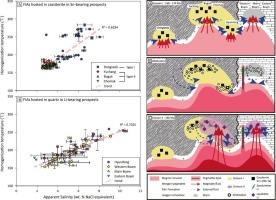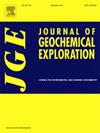Magma fractionation and the magmatic-meteoric fluids mixing drive the sequential deposition of cassiterite to lepidolite in the Uljin prospects, South Korea
IF 3.3
2区 地球科学
Q1 GEOCHEMISTRY & GEOPHYSICS
引用次数: 0
Abstract
Several Sn![]() Li prospects in the Uljin area, which is in the eastern part of South Korea, including Dongseok, Yuchang, Buguk, Chomak, Hyundong, and Boam, contain sub-economic cassiterite and Li-bearing silicate minerals such as lepidolite and spodumene, and phosphate mineral such as amblygonite, along with accessory Nb-Ta-bearing minerals. Among these, Dongseok and Yuchang are Sn-dominant, Buguk, Hyundong, and Chomak exhibit mixed Sn
Li prospects in the Uljin area, which is in the eastern part of South Korea, including Dongseok, Yuchang, Buguk, Chomak, Hyundong, and Boam, contain sub-economic cassiterite and Li-bearing silicate minerals such as lepidolite and spodumene, and phosphate mineral such as amblygonite, along with accessory Nb-Ta-bearing minerals. Among these, Dongseok and Yuchang are Sn-dominant, Buguk, Hyundong, and Chomak exhibit mixed Sn![]() Li mineralization, while Boam (Western, Main, Eastern) is Li-rich. The Sn
Li mineralization, while Boam (Western, Main, Eastern) is Li-rich. The Sn![]() Li mineralization is associated with a series of hydrothermal alterations, particularly greisenization and albitization. Two stages of greisenization have been identified, with albite alteration occurring between them. Cassiterite (± Nb
Li mineralization is associated with a series of hydrothermal alterations, particularly greisenization and albitization. Two stages of greisenization have been identified, with albite alteration occurring between them. Cassiterite (± Nb![]() Ta minerals) precipitated during early greisenization (Greisen I), whereas spodumene crystallized as a primary mineral in subsequent pegmatite intrusion, lepidolite and amblygonite formed during late-stage greisenization (Greisen II). SEM-CL analysis distinguishes two types of cassiterite: CL-brighter, oscillatory-zoned type I (commonly found in Dongseok) and CL-darker, massive type II (dominant in Yuchang, Buguk, and Chomak).
Ta minerals) precipitated during early greisenization (Greisen I), whereas spodumene crystallized as a primary mineral in subsequent pegmatite intrusion, lepidolite and amblygonite formed during late-stage greisenization (Greisen II). SEM-CL analysis distinguishes two types of cassiterite: CL-brighter, oscillatory-zoned type I (commonly found in Dongseok) and CL-darker, massive type II (dominant in Yuchang, Buguk, and Chomak).
Muscovite Ar![]() Ar dating constrains the timing of greisenization, placing Greisen I (cassiterite formation) at 168–174 Ma and Greisen II (lepidolite formation) at ~166 Ma. These overlapping ages suggest that the Sn
Ar dating constrains the timing of greisenization, placing Greisen I (cassiterite formation) at 168–174 Ma and Greisen II (lepidolite formation) at ~166 Ma. These overlapping ages suggest that the Sn![]() Li mineralization was derived from a fractionating magmatic batholith. Fluid inclusions in cassiterite and quartz contain CO2, CH4, and N2, with CH4/CO2 ratios indicating a reducing environment during early cassiterite precipitation. A positive correlation between homogenization temperatures and salinities in the fluid inclusions suggests the mixing of magmatic and meteoric fluids during cassiterite and lepidolite precipitation. The transition from Sn to Li mineralization was driven by progressive oxidation and cooling, as reflected in CO2/CH4 ratios and cassiterite chemistry. Higher-temperature (>300 °C), lower-salinity fluids (>8 wt% NaCl eq.) formed cassiterite during Greisen I, while later, somewhat cooler (>250 °C), more saline fluids (>10 wt% NaCl eq.) facilitated lepidolite precipitation during Greisen II. This magmatic-hydrothermal evolution, potentially controlled by batholith-scale magma fractionation, resulted in these sequential Sn and Li mineralization in the Uljin area.
Li mineralization was derived from a fractionating magmatic batholith. Fluid inclusions in cassiterite and quartz contain CO2, CH4, and N2, with CH4/CO2 ratios indicating a reducing environment during early cassiterite precipitation. A positive correlation between homogenization temperatures and salinities in the fluid inclusions suggests the mixing of magmatic and meteoric fluids during cassiterite and lepidolite precipitation. The transition from Sn to Li mineralization was driven by progressive oxidation and cooling, as reflected in CO2/CH4 ratios and cassiterite chemistry. Higher-temperature (>300 °C), lower-salinity fluids (>8 wt% NaCl eq.) formed cassiterite during Greisen I, while later, somewhat cooler (>250 °C), more saline fluids (>10 wt% NaCl eq.) facilitated lepidolite precipitation during Greisen II. This magmatic-hydrothermal evolution, potentially controlled by batholith-scale magma fractionation, resulted in these sequential Sn and Li mineralization in the Uljin area.

在韩国蔚珍地区,岩浆分馏作用和岩浆-大气流体混合作用驱动了锡石到锂云母的序贯沉积
在韩国东部的蔚珍地区,东锡、余昌、釜国、Chomak、hyundai和Boam等几个SnLi远景区,含有亚经济锡石和含锂硅酸盐矿物(如锂云母和锂辉石)、磷矿(如闪长石)以及辅助含铌钽矿物。其中,东石、余昌以锡矿为主,北国、现代、乔马为混合矿化,波岩(西、美、东)富锂。SnLi矿化与一系列的热液蚀变有关,特别是辉绿岩化和钠长岩化。确定了两个阶段的灰石化,其间发生钠长岩蚀变。锡石(±NbTa矿物)在早期辉石化(Greisen I)中沉淀,而锂辉石在随后的伟晶岩侵入中作为主要矿物结晶,而在辉石化后期(Greisen II)中形成了锂云母和辉长石。SEM-CL分析将锡石分为两种类型:cl -亮、振荡带型I型(常见于东石)和cl -暗、块状型II型(主要见于于昌、北国和乔马)。muscoite ArAr定年限制了灰石化的时间,将Greisen I(锡石组)定在168-174 Ma,而Greisen II(锂云母组)定在~166 Ma。这些年龄的重叠表明,SnLi矿化来源于岩浆基的分选作用。锡石和石英流体包裹体中含有CO2、CH4和N2, CH4/CO2比值反映了早期锡石降水的还原环境。流体包裹体的均一化温度与盐度呈正相关关系,表明锡石和锂云石沉淀过程中岩浆流体与大气流体混合。从CO2/CH4比值和锡石化学特征可以看出,锡矿化向锂矿化的转变是由逐渐的氧化和冷却驱动的。Greisenⅰ期间,温度较高(300℃)、盐度较低的流体(8wt % NaCl当量)形成了锡石,而后来,温度稍低(250℃)、盐度较高的流体(10wt % NaCl当量)促进了Greisenⅱ期间的锂云石沉淀。这种岩浆-热液演化可能受岩心级岩浆分馏作用的控制,导致了Uljin地区连串的锡、锂成矿作用。
本文章由计算机程序翻译,如有差异,请以英文原文为准。
求助全文
约1分钟内获得全文
求助全文
来源期刊

Journal of Geochemical Exploration
地学-地球化学与地球物理
CiteScore
7.40
自引率
7.70%
发文量
148
审稿时长
8.1 months
期刊介绍:
Journal of Geochemical Exploration is mostly dedicated to publication of original studies in exploration and environmental geochemistry and related topics.
Contributions considered of prevalent interest for the journal include researches based on the application of innovative methods to:
define the genesis and the evolution of mineral deposits including transfer of elements in large-scale mineralized areas.
analyze complex systems at the boundaries between bio-geochemistry, metal transport and mineral accumulation.
evaluate effects of historical mining activities on the surface environment.
trace pollutant sources and define their fate and transport models in the near-surface and surface environments involving solid, fluid and aerial matrices.
assess and quantify natural and technogenic radioactivity in the environment.
determine geochemical anomalies and set baseline reference values using compositional data analysis, multivariate statistics and geo-spatial analysis.
assess the impacts of anthropogenic contamination on ecosystems and human health at local and regional scale to prioritize and classify risks through deterministic and stochastic approaches.
Papers dedicated to the presentation of newly developed methods in analytical geochemistry to be applied in the field or in laboratory are also within the topics of interest for the journal.
 求助内容:
求助内容: 应助结果提醒方式:
应助结果提醒方式:


